“A designer is an emerging synthesis of artist, inventor, mechanic, objective economist and evolutionary strategist.” - Buckminster Fuller
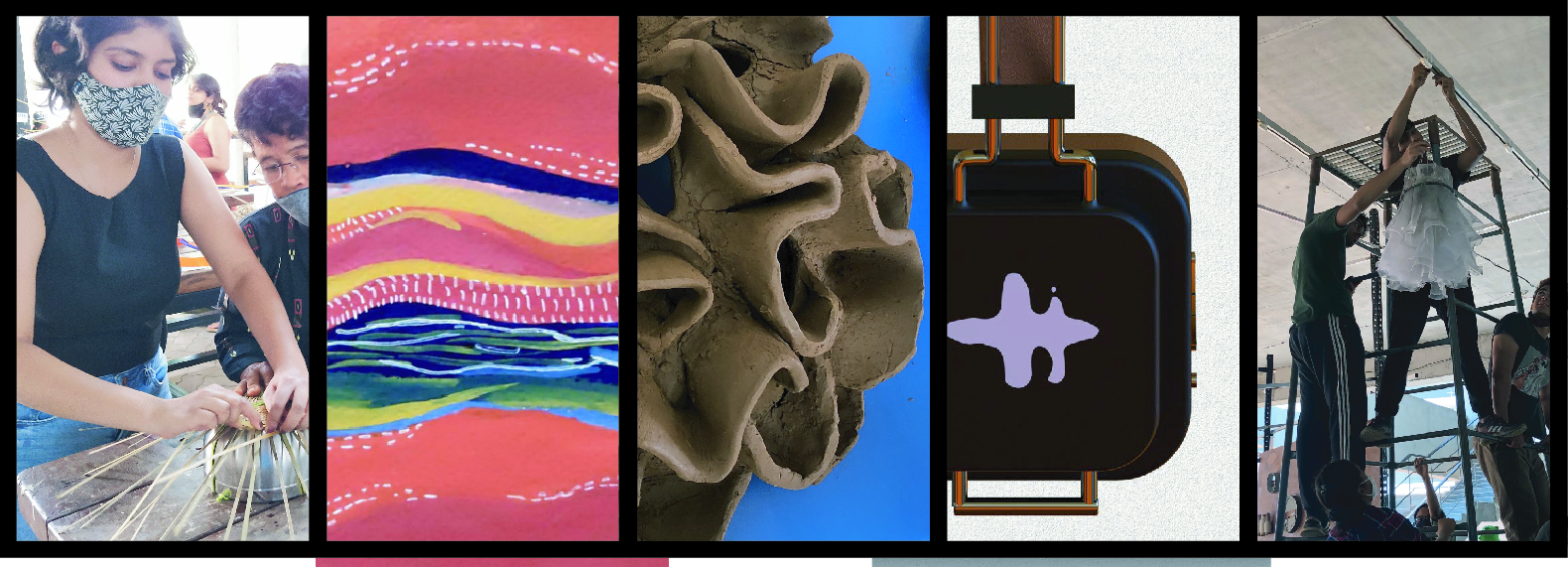
Vision
How do we set priorities in design? Do we design for people, for the market, for the environment or to express our creative selves? Today as we move to planet-centric design, the question is, how can we shape our practice such that whatever we create is inclusive and caring in nature for a larger, common good? This is a tall ask but as creative practitioners who are trained to ‘make things better’ we often inadvertently do the opposite. Apart from our focus on solving immediate local problems, we also need to consider the impact of our creations on the planet.
In nature, form and structure coexists in the most elegant and harmonious ways. Is it possible for us, as the designers of tangible and intangible man-made objects, to mimic such ecologically prudent ecosystems that are cyclic and regenerative? As responsible designers, we need to begin to use limited resources in frugal and efficient ways and not just design for the sake of doing something ‘new’
Design is about connecting all the dots – how things are made, who makes them, how things are used, who uses them and what happens to these things when they are thrown away. Design is about imagining better futures while taking forward the best of our past. India has a rich history in craft and making and artisans were the first designers. Today we can learn from their frugal practices to design more sustainable products and systems.
The future of ‘how things are made’ is rapidly changing with new technologies and possibilities emerging every day. What does this mean for the designer of the future? There is an increasing move towards engaging directly with materials, tools and emerging technologies like 3D printers is making this think-able and do-able, easier and simpler. Through the course we engage with making at different levels – to acquire skills, to express creative ideas, to have conversations with materials, to think critically and much more. We use making as a way of thinking in the design/art process.
The Industrial Arts and Design Practice course is based on the idea of “making” as a way of thinking. We believe that making is the connection between the head and the heart. Hands-on making leads to an enduring understanding of design and art processes, and allows us to learn with intuition and sensitivity.
As practitioners each of us can find our unique position in the maker space, be it amongst contemporary handcrafted artefacts or adding value to mass-produced objects of everyday use. This course allows you to find out what kind of creative person you are and facilitates your individual development as an artist or designer.
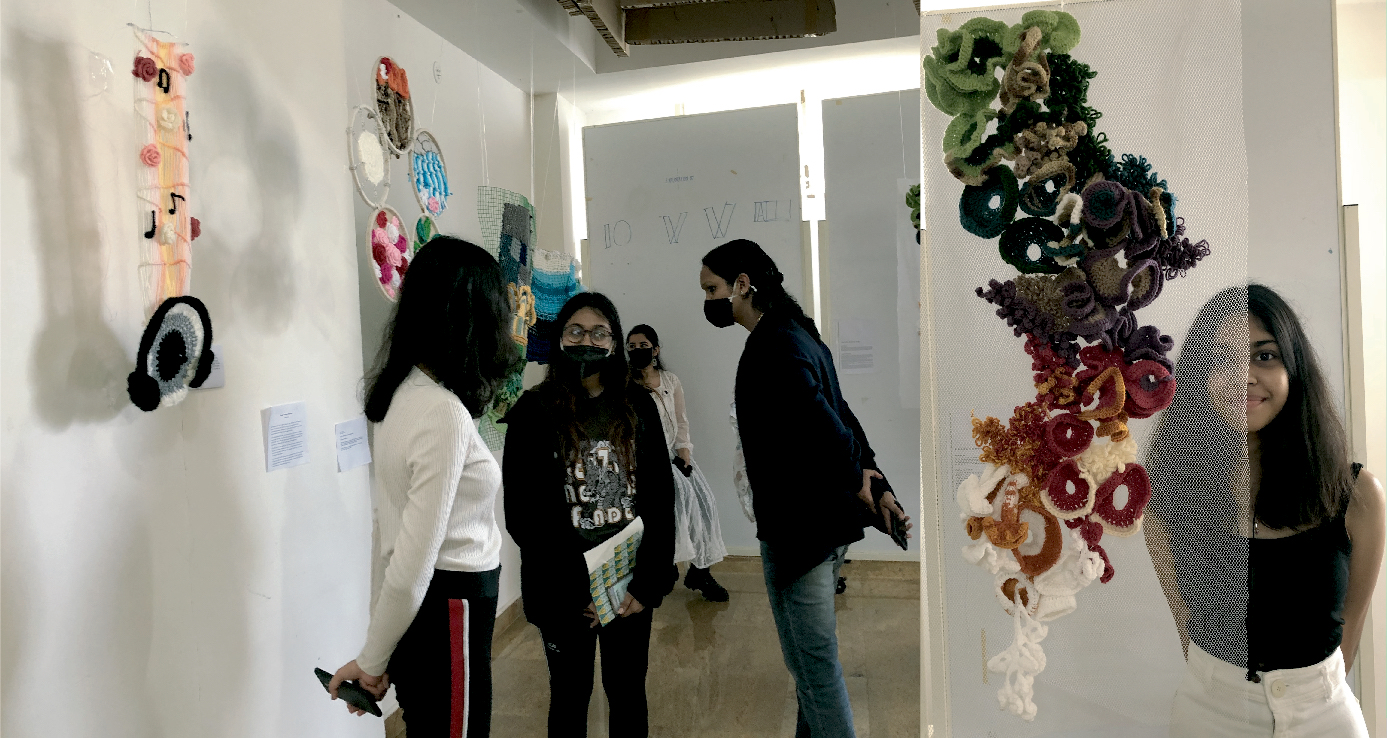
Studio: Transformation with Textile
Core Values
- Open
- Hands-on
- Inclusive
- Frugal
- Playful
- Caring
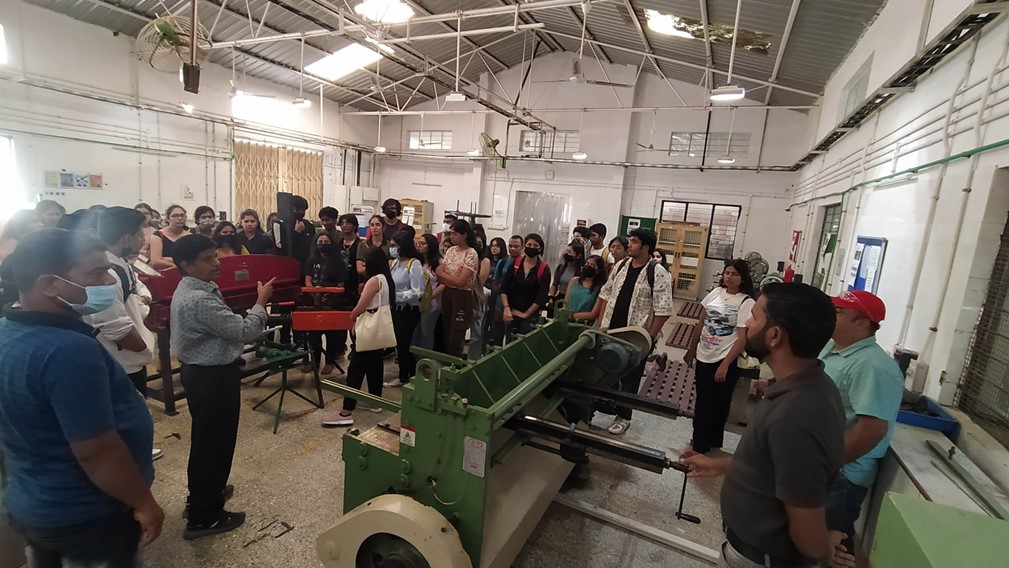
Being introduced to the Workshop spaces
Course Structure
The curriculum comprises of different ways of learning as follows:
- Foundation introduces students to basic principles and tools of Art, Design and Technology as methods, tools and processes. Read more >>
- Disciplinary Studios are learning spaces where students develop core disciplinary capabilities, while navigating a trans-disciplinary environment
- General Studies is a common and compulsory programme of study that integrates Humanities, Sciences, Maths, business and finance. Development and Policy Studies and also offers Languages (Spanish, French and German) Read more >>
- Interim is an immersive introduction to practice in new and emerging areas of art and design and environmental exposure
- Electives are of three kinds - this program allows students to expand their skills, develop the interests as well as provide opportunities for travel exchange
- Internship/Apprenticeship is compulsory work experience done over the summer-break between the 6th and 7th semester
- Project based learning involves the application and synthesis of capabilities acquired. Two projects, pre-thesis and thesis, is culmination of the 4-year undergraduate program, which allows for demonstration of an integration of values, positions, capabilities and practice. Read more >>
Learning Approach
Learning at the Bachelor of Design in Industrial Arts and Design Practices involves
- First hand learning through making and managing materials, processes and technologies enabling industriousness as a virtue
- Harnessing expertise and rich making skills available extensively at all levels in the Indian context through Locative Making
- Exploring, playing and innovating, making connections between the old, the present and the future to discover new potential
- Researching, combining and collaborating craft and technology. Acquiring and using the skills of both the craft industry as well as the technologies and processes of the future with empathy and sensitivity
- Synthesizing and realizing concepts by making and validating from a stakeholder’s perspective through various hands on visualization and translation methods, managing complex systems, developing autonomy
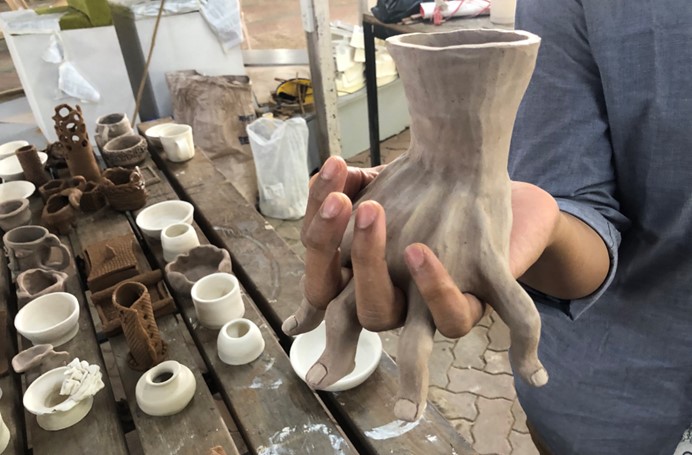
Workshop: Crafting with Clay
Capability Sets
Upon successful completion of this course graduates will have developed the following capabilities:
Working with Material
- Acquire a proficiency in working with specific materials and processes, as well as explore a wide range
- Understand and use technologies from the traditional, contemporary to futuristic
- Play and innovate with new materials and technologies to make new connections
- Develop curiosity and respect for material, processes and people
Learning through Making
- Be proficient in using the design process and creative thinking skills and tools- research methods, tools for analysis, ideating, prototyping, testing and validating
- Be proficient in expression through drawing and prototyping
- Explore and experiment in a hands-on manner with materials, processes and techniques in order to develop understanding appropriate and sustainable uses
- Use Making as a conceptual thinking tool for envisioning and translating abstractions into tangible forms
Manage Complexity
- Develop an ability to detail, plan and manage - materials and resources to arrive at a final finished outcome
- Understand the Impact of one’s practice through different lens – Experimentation, Humanity, and Business leading to positioning of one’s practice in a larger framework
- Develop an ability to create frameworks through Making and Reflective response with art, craft and design techniques, processes, and contemporary ways of perceiving art and design worlds.
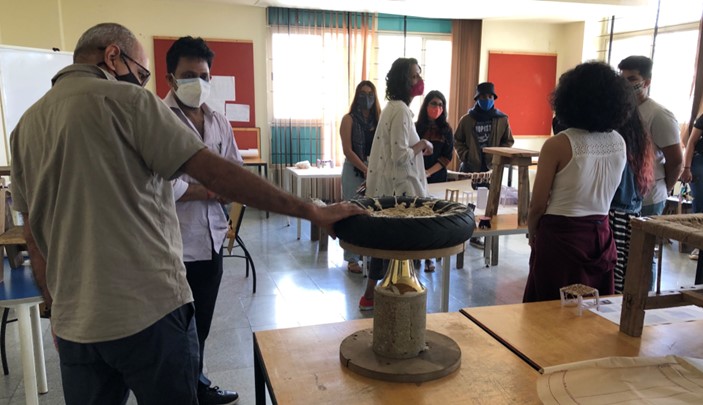
Classroom critique
Opportunities
The above capability sets equip and prepare the student for a wide range of career opportunities with:
- Creative Manufacturing Sectors – Engaging with artisans and craft units at a small and medium scale and become part of the growing global phenomenon of the Maker movement
- New Product Envisioning and Design studios, R&D departments - Disseminating creative energies as a team player in small & large industries, and multinational corporations
- Grass root development organizations, NGOs & Social Enterprises – Bringing in a breath of fresh air and a new perspective to the conventional, through a blend of creative, technical and business acumen
- Start-ups, small and medium enterprises – Propositioning as a contemporary craft practitioner, entrepreneur, design consultant
- Emerging and Trans-disciplinary Domains – Merchandising and Strategic Product Planning in Retail, UI & UX in e-commerce for the transactions of the future
People
Enquiries

Disciplinary Intersections
The program is informed by the following learning disciplines:
Product and Interface Design
Furniture Design
Information Design
Interaction Design
Visual Communication Design
Research and Collaboration
The students under this program will have the opportunity to work with the following centers and labs at Srishti.
Impact Edge
LeNS Lab
Frugal Design DESIS Lab
Center for Education, Research, Training, and Development (CERTAD)
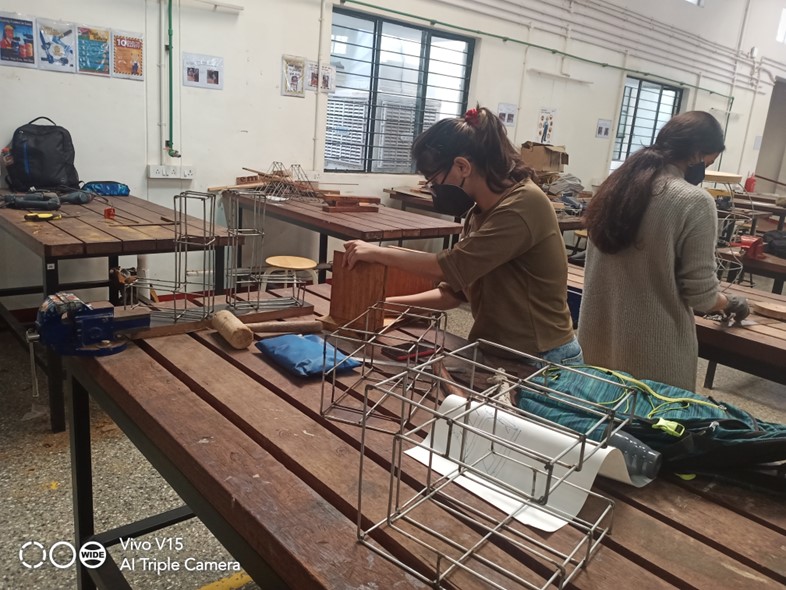
Prototyping in the workhop
FAQs
A variety of options are available for a graduate in Industrial Arts and Design Practices (IADP)
- A job in Industry eg. A textile designer could get a job with an export house, a student interested in Furniture Design could get a job in any of the online or retail Furniture stores like Urbanladder or Dovetail, a product designer work in the design department of large companies like Godrej, TVS etc.
- Work in any of the numerous Design studios like Foley Design, Elephant Design, Desmania etc.
- Work in an NGO in the craft sector like Dastakar, Sasha etc.
- Set up an independent practice as a Design Entrepreneur
Companies such as IBM, Tata Elxsi, Selco, Himatsingka, Sasha and many more have absorbed our graduates.
Srishti Manipal Institute does not offer placement in the way that other Institutes do. We have other means of connecting students to Industry. Students have to do a mandatory Internship at the end of the 3rd year. At the end of the 4th year we design and set up a public online exhibition of all graduating student’s work. People from Industry are invited and this serves as a good platform for students to interact with the larger world.
During the Studio years (Year 2 and 3) IADP offers units in textile, furniture and product design every year, in parallel. Students are free to choose the units that interest them. A student who is focused on textile design can choose only those units and then work on textile based projects in the 4th year. The degree awarded on completion will be a Bachelor of Design in Industrial Arts and Design Practices.
During the Studio years (Year 2 and 3) IADP offers units in textile, furniture and product design every year, in parallel. Students are free to choose the units that interest them. A student who is focused on furniture design can choose only those units and then work on textile based projects in the 4th year. The degree awarded on completion will be a Bachelor of Design in Industrial Arts and Design Practices.
We don’t offer a specialization in Fashion. However a good base in textile art and design will certainly help a future fashion designer.
The emphasis in IADP is not on teaching software skills. Students are expected to pick up relevant skills in Adobe Suite and Microsoft office on their own. Some 3D software especially the Autocad suite are introduced in a workshop mode. However it is only through use and practice that students can gain a mastery over these.
Most Industrial design courses focus on mainstream Industry. Our course allows students to explore creative interests while being mentored by faculty drawn from a large pool of artists and designers.
Many Institutes offer a narrow pathway that allows you to specialize only in one discipline. We encourage navigation across courses, trans-disciplinary learning so that you are able to deal with a variety of contexts and issues. Through this pathway of learning, you would explore as well as acquire an understanding about the larger eco-systems that design, designers and artists operate in – be it at in an art and craft cluster or an industry level.
Srishti manipal Institute has well equipped and staffed workshops for weaving, print, wood and metal work and electronics. Our workshop has a laser cutter and 3D printers.
The three options that a student has on completion of this course are
- Pursue a masters degree in Srishti Manipal Institute of Art, Design and Technology or elsewhere
- Apply and get a job in Industry, government or non-government sector
- Be a design entrepreneur
We facilitate students in creating their portfolios and applying for internships across India.
A list of our units is published in the Prospectus for your reference. Most of our units are hands-on. We teach design/art thinking processes using making as a way of learning.
Industry can be defined as any place of work along with economic activity. This includes manufacturing, production, fabrication and construction at any scale be it a small cottage industry or a large production unit. This also includes design futures and students are encouraged to think and work with the future of production and consumption.
There is a lot of hands-on making in many of the learning units we offer. There is focus on craft as a context for learning. There is an equal focus on design futures and design thinking. Students iteratively learn the design/art process through all the units and also apply this in the 2 projects in the 4th year. This enables them to work in the context and industry of their choice. Final year projects offer a choice of contexts, so both craft and mainstream industry are represented.
We train our students to think creatively and embrace new situations and contexts and this is highly valued by Industry today. Learning to learn is an important part of our pedagogy and students are able to adapt easily to whichever Industry they work in. Students acquire design/art thinking skills which are applicable across various kinds of industry.
Remuneration is largely based on the sector that the young designer wants to work in. For example, starting salaries in craft based NGOs are typically less than what an Industrial Design studio may offer. A lot depends on the student’s portfolio too, and we mentor students to create portfolios that reflect who they are.
Yes, after a B.Des. in Industrial Arts and Design, students can pursue a Masters degree at Srishti Manipal and at other Institutes in India and abroad. They can opt for varied kinds of programs that delve into directly related fields.
Please email us at naganandini.d@manipal.edu




